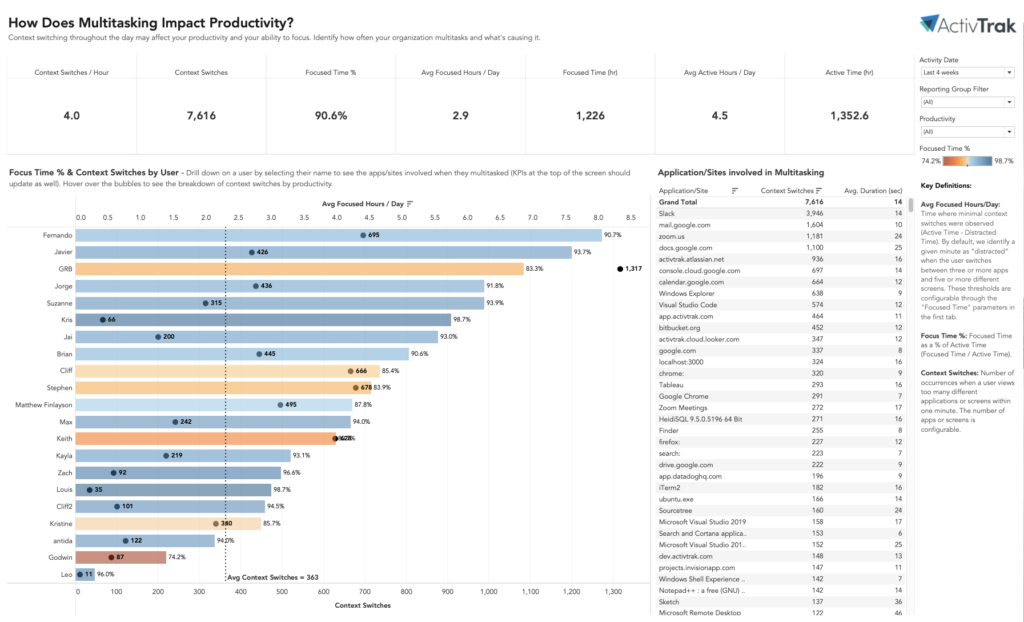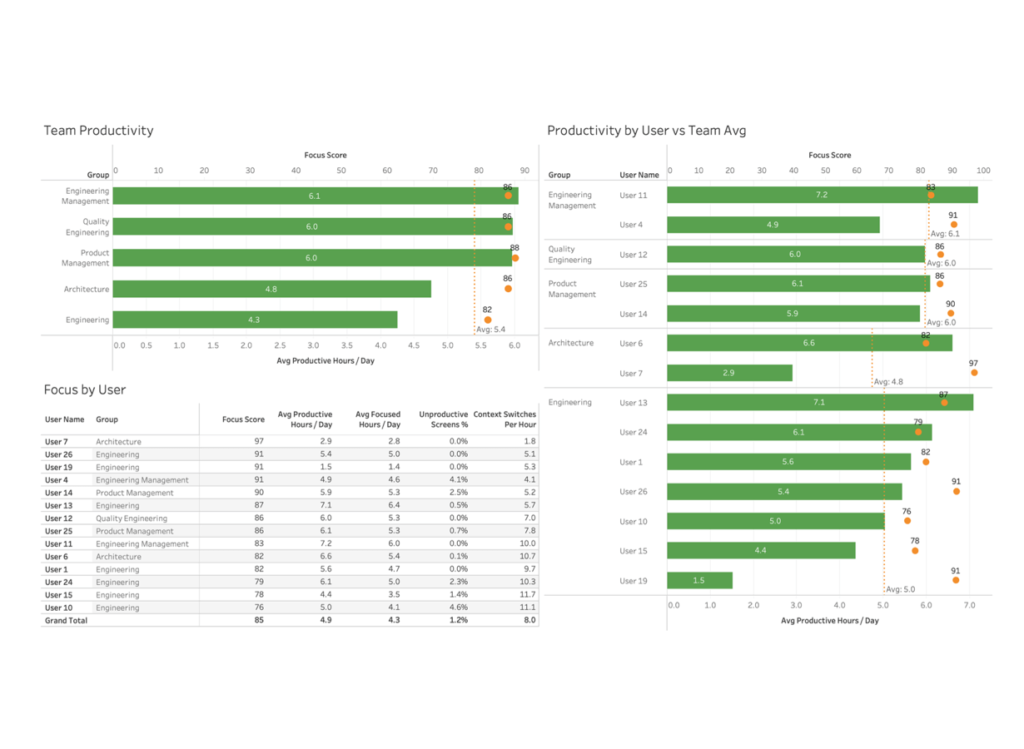A typical knowledge worker spends the bulk of their days jumping between video calls, emails, business apps, and collaboration tools. They also face a string of coworker interruptions and the constant pull of texting, phone calls, and social media. Put them all together, and it’s easy to see why context switching (aka multitasking) can be a drain on productivity.
Many employees believe that multitasking is normal and that by working harder (and faster), they can handle anything thrown their way. However, as organizations learn more about the strain of context switching, it’s becoming clear that multitasking interferes with the ability to focus and can actually decrease productivity and work quality.
What is context switching?
Context switching involves simultaneously engaging in two or more complex yet unrelated tasks. In most instances, people find themselves bouncing between these activities at random intervals. This stop-and-go behavior can be caused by external forces (e.g., coworkers distracting other employees) or by employees choosing to interrupt their own workflow.
Why is it harmful?
One of the main issues with context switching is that workers seldom realize the problem even exists. For example, a UC Irvine study showed that context switching is commonplace amongst tech workers.
In one financial services firm, 57% of IT staff were interrupted during daily assignments and spent a mere 11 minutes on each task before switching to another. Employees then participated in two or more intervening activities before resuming their original assignment.
These types of interruptions are especially harmful when you consider that the average time to reach peak creative focus (or a state of “flow”) is between 15-20 minutes. This same research noted that employees were just as likely to interrupt themselves as they were to be distracted by others.
And there’s more evidence that interruptions are strangling workplace output.
Context switching reduces productivity
Although we equate more work with higher productivity, that’s not always the case. In a paper published on the American Psychological Association website, adults who repeatedly switch tasks exhibited lower overall productivity than those who focused on a single assignment. Researchers equate this reduction in output to how our brains manage competing inputs.
Each change of focus requires our mind to make two separate yet distinct decisions.
The first is known as “goal shifting” and establishes what we want to accomplish. The second decision, “rule activation,” is when the brain turns off guidelines from the previous task and enables new rules for what happens next. Although this entire process happens in tenths of a second, the resulting productivity drop has a ripple effect.
In his book, Quality Software Management: Systems Thinking, computer scientist Gerald Wineberg says that context switching can reduce employee productivity by 80%. According to Wineberg, we lose 20% of our productivity power with each new simultaneously juggled task. Thus, if we take on five competing assignments in one hour, losing our state of “flow” costs us up to 80% of what we could have accomplished otherwise.

Context switching leads to lower-quality work
Organizations might assume that a drop in focus would correlate with less productivity. Not exactly. For example, in another UC Irvine study, researchers found that employees who encountered frequent interruptions simply worked faster to make up the difference.
Workers accounted (mentally) for the time they lost to these interruptions and made up for it on the back end. While employees who “push” themselves may feel like they are keeping up with their peers, the quality of their work suffers in the long run.
Context switching hurts morale
Context switching also takes an emotional toll on workers. The pressures of juggling multiple tasks and deadlines create stress and anxiety. Some say completing additional tasks makes people happier, but research says otherwise.
Employees often acknowledge feelings of guilt about not keeping pace and may develop anxiety over the quality of their work. According to a Harvard Business Review article about multitasking and happiness, the amount of time spent on tasks correlates with perceived happiness.
In this study, participants were asked to rate their overall satisfaction based on the number of tasks assigned over a brief period. Those who were given fewer jobs (but with extra time to complete each) reported feeling more productive and happier in the short term.
However, the results also showed that working on multiple projects for extended intervals (days, weeks, months) produced similar overall satisfaction levels. Sustained focus periods were the differentiating factor in both outcomes.

Context switching decreases profitability
Not surprisingly, the combination of these negative factors is bad news for business. Estimates vary, but organizations equate losing approximately 450 billion dollars annually to the productivity roadblocks of context switching. In a recent Forbes article, leadership strategist Curt Steinhorst says that multitasking (and distractions in general) consume roughly 2.1 hours of the average employee’s day.
Multiply those numbers annually, and companies face more than 500 hours of salary costs per employee with no direct benefit. Depending on the size of the organization, these expenses only amplify.
What can you do to reduce context switching?
There are many techniques you can use to reduce context switching and encourage focused work patterns in your organization. A few ideas include:
- Make a to-do list and prioritize the tasks that require the most focused thought and effort.
- Schedule time on your calendar to focus on completing focused work; just as you would for a meeting with other team members.
- Turn off email and messaging app notifications during your focused time.
- Put a message on your messaging app profile that you are doing focused work, and to only interrupt with truly urgent items.
- Designate one day a week as “meeting-free”. At ActivTrak, we have implemented “Focus Fridays”. If a full day is not feasible, challenge your teams to find at least a half day per week that is meeting-free and can be used instead to focus on tasks and projects that require concentration. Make it a company norm to try to respect this time.
- Experiment with team-wide “quiet hours” on messaging apps.
- Provide flexibility for employees to work from home when they need uninterrupted focus time.
- Encourage employees to take breaks throughout the day. The Pomodoro Technique breaks down work into intervals with short breaks to help the brain reset and refocus. There are differing opinions on how long these intervals should be, ranging from 25 minutes to 90 minutes of focused work, and breaks ranging from 2 minutes to 30 minutes. It’s important for each individual to find what works best for them.
How do you know if these changes are working?
Outside of qualitative feedback from employees on the degree to which they are able to carve out sustained periods of focus, it can be difficult to assess the impact of context switching. However, workforce analytics solutions like ActivTrak are providing new ways for organizations to assess important productivity metrics like focus time, burnout risk, context-switching, and more. This makes it possible for teams and organizations to experiment with some of the solutions described above, and gather actual quantitative data to understand if the desired outcomes were achieved – namely, an increase in focus time and a decrease in context-switching.
To see this in practice, the ActivTrak product team became its own case study by trying some of the solutions mentioned above and comparing the before/after data, along with feedback from team members to validate “hunches” on ways they could improve team productivity. Check out this webcast to see what they learned.
Improve productivity by reducing context switching
While the pace of today’s digital workplace can make it feel like rapidly replying to messages and checking items off your to-do list is “productive”, that may not actually be the case. As we’ve explored, context switching, commonly known as multitasking, causes numerous, unintended negative effects in the workplace. These include reductions in work outputs and the quality of those outputs, lowered morale, and decreased profitability due to the inefficient use of time by employees.
The good news is that context switching can be measured and improved upon. Ready to get visibility into context switching in your own organization? Create a free ActivTrak account today to get started.
Take your data further with ActivConnect
Already an ActivTrak customer? Easily integrate your ActivTrak data with your software stack for deeper analytics into how work gets done, including insights into context switching with premade report templates. Learn more.
About ActivTrak
ActivTrak is a workforce productivity and analytics software company that helps teams understand how people work, whether in-office or remote. Our cloud-based user activity monitoring platform collects and analyzes data and provides insights to help organizations be more productive and operationally efficient. With more than 8,000 customers and over 250,000 users of its free version, ActivTrak’s award-winning solution can be configured in minutes to identify operational bottlenecks, flag operational compliance risks, and provide valuable insights that help employees and employers improve productivity outcomes.





